As you consider adding an umbrella plant to your indoor space, you’re likely drawn to their large leaves and low-maintenance nature. With proper care tips, your umbrella plant can thrive, bringing a touch of natural beauty to your home. Umbrella plants, also known as indoor plants, are perfect for beginners and seasoned gardeners alike, and can grow up to 3m tall with evergreen foliage.

Whether you’re looking to purify the air, add some aesthetic appeal, or simply enjoy the benefits of having an indoor plant, this guide will walk you through everything you need to know about umbrella plants. From planting and caring to enjoying the benefits of your new plant, we’ve got you covered with expert care tips.
Table of Contents
What is an Umbrella Plant?
As you consider adding a new houseplant to your collection, you may have come across the umbrella plant, also known as Schefflera arboricola. This plant is a popular choice for indoor spaces due to its unique, umbrella-like leaves and relatively low-maintenance plant care requirements.

With approximately 500 species of Schefflera existing, only four are suitable for houseplant cultivation. The dwarf umbrella tree (Schefflera arboricola) can grow up to 4 meters in its natural habitat but remains under 2 meters tall when cultivated as a houseplant.
Overview of the Umbrella Plant
The umbrella plant is native to Taiwan and tropical Australia, and its large leaves make it a stunning addition to any room. To keep your umbrella plant thriving, it’s essential to provide it with the right conditions, including proper plant care and maintenance.
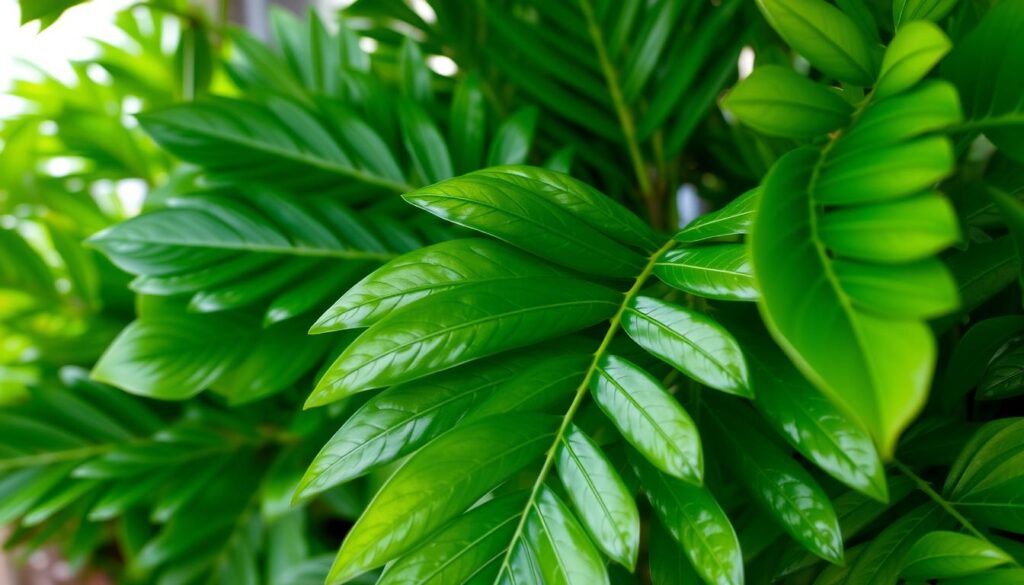
Scientific Classification
The umbrella plant belongs to the Araliaceae family and is known for its ability to grow up to 30 centimeters per year under ideal conditions. With proper plant care, your umbrella plant can become a beautiful and thriving addition to your indoor space, making it a great choice for those who enjoy houseplants.
| Characteristics | Description |
|---|---|
| Height | Up to 4 meters in natural habitat, under 2 meters as a houseplant |
| Growth Rate | Up to 30 centimeters per year |
| Native to | Taiwan and tropical Australia |
Benefits of Having an Umbrella Plant
Having an umbrella plant can bring numerous benefits to your indoor space. Not only do they add a touch of elegance with their large, green leaves, but they also help purify the air and are relatively low-maintenance. To keep your umbrella plant thriving, it’s essential to learn how to grow and care for it, including proper pruning techniques and propagation methods.
Some of the benefits of having an umbrella plant include:
- Aesthetic appeal: Umbrella plants are known for their beautiful, large leaves that can add a touch of elegance to any room.
- Air purification: Umbrella plants are effective at removing indoor air pollutants, such as benzene and formaldehyde, making them a great addition to any home.
- Low maintenance: Umbrella plants are relatively easy to care for, making them a great option for busy people or those new to plant care.
By learning how to properly care for your umbrella plant, including pruning and propagation, you can enjoy the many benefits it has to offer. With its low-maintenance requirements and air-purifying abilities, an umbrella plant is a great addition to any home.
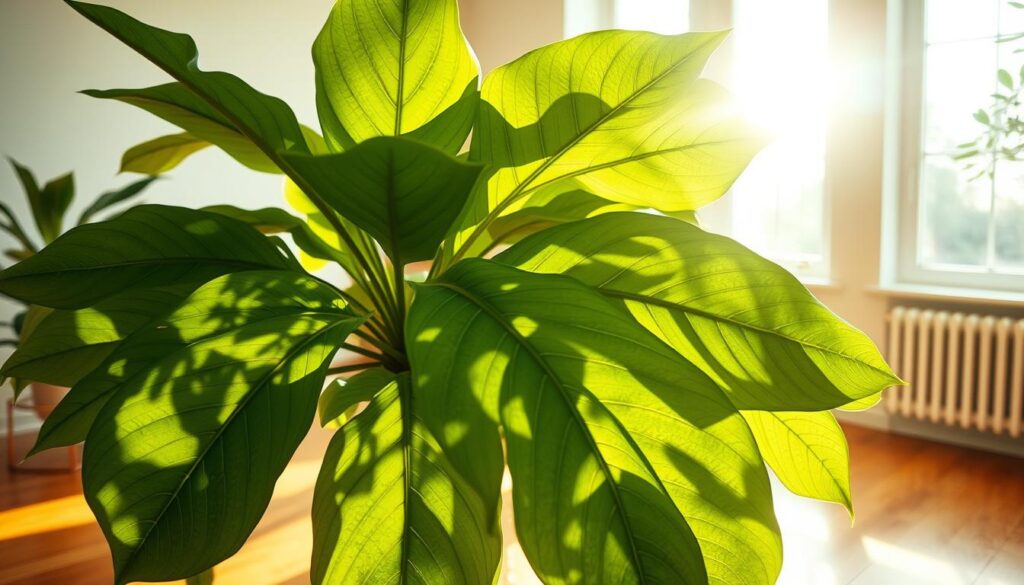
| Benefit | Description |
|---|---|
| Aesthetic appeal | Large, green leaves add a touch of elegance to any room |
| Air purification | Effective at removing indoor air pollutants, such as benzene and formaldehyde |
| Low maintenance | Relatively easy to care for, making it a great option for busy people or those new to plant care |
Choosing the Right Location
When it comes to caring for your umbrella plant, choosing the right location is crucial. As a general rule, indoor plants thrive in bright, indirect light, making them perfect for rooms with large windows. However, it’s essential to consider the specific needs of your umbrella plant, including light requirements, temperature, and humidity.
To ensure your umbrella plant receives the right amount of light, place it near a window with a sheer curtain to filter the sun’s rays. This will provide the perfect balance of light and shade, allowing your plant to photosynthesize and grow. In terms of temperature, most houseplants, including umbrella plants, prefer temperatures between 65-75°F (18-24°C). Avoid placing your plant near heating or cooling vents, fireplaces, or drafty windows, as this can cause stress and affect its growth.
Here are some care tips to keep in mind when choosing the right location for your umbrella plant:
- Humidity levels: Umbrella plants prefer humidity levels above 40% for optimal health and moisture absorption.
- Lighting: Place your plant near a window with bright, indirect light, avoiding direct sunlight, which can cause leaf scorch.
- Temperature: Keep your plant in an area with a consistent temperature between 65-75°F (18-24°C).
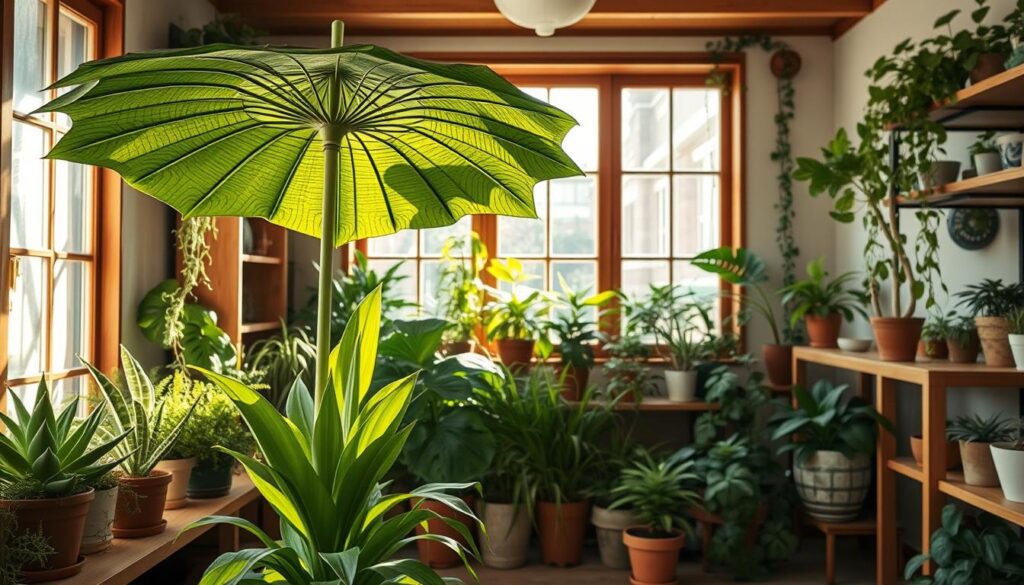
By following these care tips and choosing the right location for your umbrella plant, you’ll be well on your way to creating a thriving and beautiful indoor space. Remember to monitor your plant’s response to its environment and adjust its location as needed to ensure it receives the right amount of light, temperature, and humidity.
| Location | Lighting | Temperature | Humidity |
|---|---|---|---|
| Near a window | Bright, indirect light | 65-75°F (18-24°C) | Above 40% |
| Away from heating or cooling vents | Filtered sunlight | Consistent temperature | Between 40-60% |
Planting Your Umbrella Plant
When it comes to planting your umbrella plant, also known as Schefflera arboricola, choosing the right soil is crucial for its growth and development. You’ll want to select a well-draining potting mix that’s specifically designed for indoor plants. This type of soil will help prevent waterlogged soil and root rot, which can be detrimental to your umbrella plant’s health.
In terms of potting techniques, make sure to handle the roots with care and gently place the plant in its new pot. It’s essential to leavecha enough space for the roots to grow and expand. A general rule of thumb is to repot your umbrella plant every 2 to 3 years to provide fresh soil and a larger pot if necessary. Proper plant care, including repotting, will help your umbrella plant thrive and reach its full potential, which can be up to 3 meters tall.
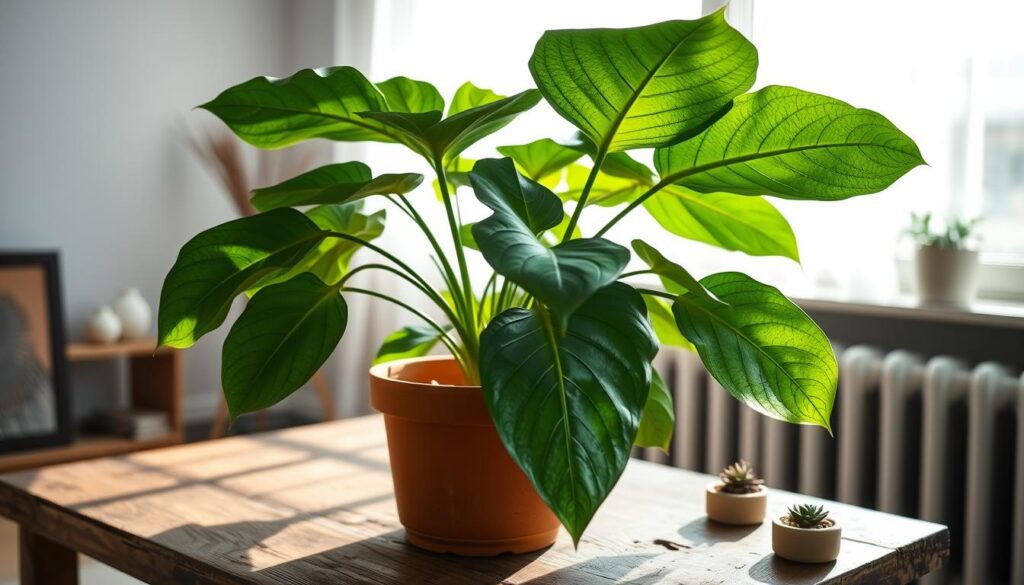
Some key things to keep in mind when planting your umbrella plant include:
- Using a pot that’s only slightly larger than the previous one to prevent the soil from becoming too wet
- Avoiding over-handling the roots, which can cause damage and stress to the plant
- Watering sparingly after repotting to prevent shocking the roots
By following these simple steps and providing your umbrella plant with the right conditions, you’ll be well on your way to becoming a successful plant parent and enjoying the many benefits of having an umbrella plant in your home.
Watering Your Umbrella Plant
When it comes to caring for your umbrella plant, watering is a crucial aspect to get right. To ensure your plant stays healthy and thrives, it’s essential to understand the best care tips and how to grow houseplants like umbrella plants. Proper watering techniques will help prevent common issues like root rot and leaf drop.
Umbrella plants require careful attention to their watering needs. As a general rule, these plants need to be watered every 1 to 2 weeks, allowing the soil to dry out between waterings. It’s also important to check the soil moisture by sticking your finger into the soil up to the first knuckle. If the soil feels dry, it’s time to water your plant.
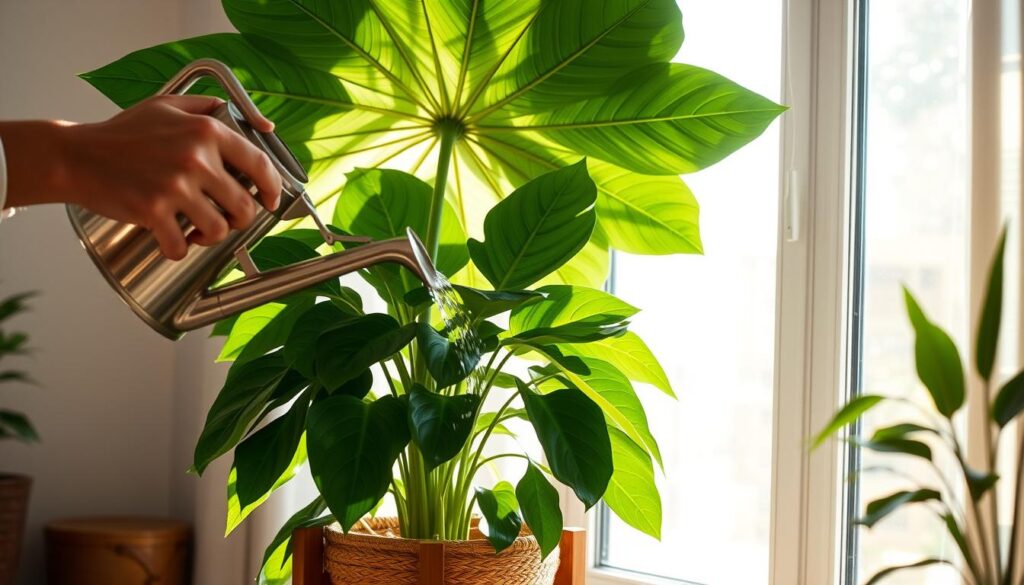
To avoid overwatering, make sure not to get water on the leaves or crown of the plant. Instead, water at the soil level, allowing the plant to absorb the water as needed. Underwatering can also be a problem, so it’s essential to find a balance that works for your plant. By following these care tips and understanding how to grow houseplants, you’ll be well on your way to becoming an expert in umbrella plant care.
Signs of Overwatering
- Yellowing or droopy leaves
- Soft, mushy stems
- Root rot or a foul odor from the soil
Signs of Underwatering
- Wilting or crispy leaves
- Slow growth or leaf drop
- Dry, cracked soil
By being mindful of these signs and adjusting your watering schedule accordingly, you can help your umbrella plant thrive and enjoy its beautiful, unique foliage. Remember, proper care and attention to your plant’s needs are key to its success, and with the right care tips and techniques, you can enjoy your umbrella plant for years to come.
Fertilizing Umbrella Plants
When it comes to fertilizing your umbrella plant, it’s essential to use a balanced fertilizer that provides the necessary nutrients for healthy growth. Nitrogen, phosphorus, and potassium are the primary nutrients required for plant care, with each playing a vital role in the plant’s development. For example, nitrogen is necessary for chlorophyll and amino acid creation, influencing green foliage, while phosphorus is essential for root and flower development.
Avoid over-fertilization, as it can result in stunted growth and yellowing lower leaves. Regular soil tests should be done to monitor nutrient levels and avoid deficiencies, ensuring proper nutrient management. Fertilization should occur monthly from spring until fall, and bi-weekly for enhanced growth if desired. In winter, fertilization frequency should be decreased, as plants typically show reduced growth during this time.
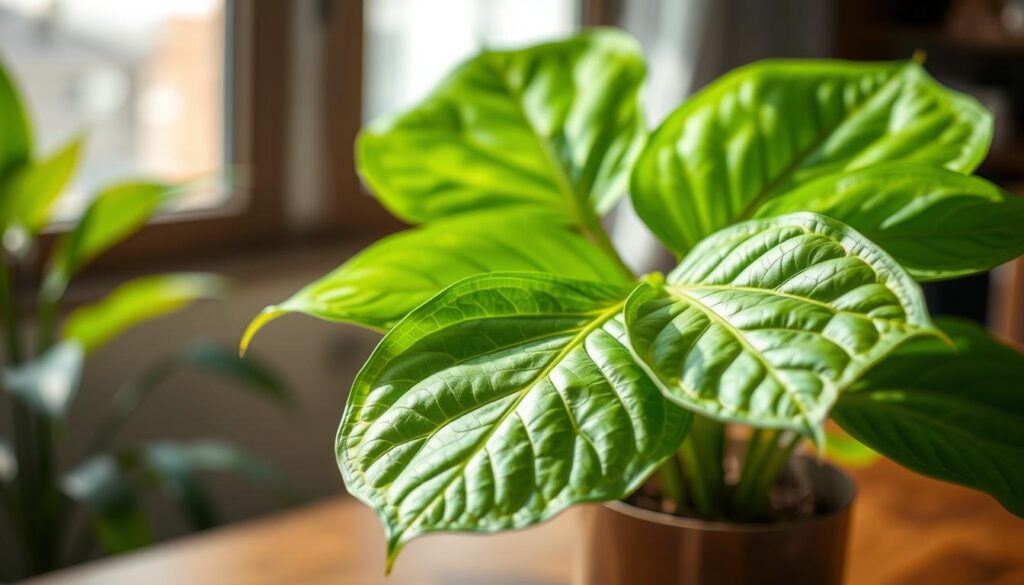
- Balanced formula of 20-20-20
- High-nitrogen low-phosphorus fertilizers like 18-6-12
- Organic formulas such as 2-2-2 and 2-1-1
Remember to dilute liquid fertilizers to about a quarter strength of the recommended dose to avoid root burn, and evenly distribute granular fertilizers away from plant stems to prevent damage. By following these tips and incorporating pruning and propagation techniques into your plant care routine, you can help your umbrella plant thrive.
| Fertilizer Type | Nitrogen | Phosphorus | Potassium |
|---|---|---|---|
| 20-20-20 | 20% | 20% | 20% |
| 18-6-12 | 18% | 6% | 12% |
Pruning and Maintenance
As you care for your umbrella plant, also known as Schefflera arboricola, pruning is an essential part of maintaining its health and appearance. Pruning your umbrella plant at the right time is crucial, and the best time to do so is in the spring or summer for houseplants, and in the spring or fall for outdoor plants.
To prune your umbrella plant, you will need a clean pair of pruners. It is recommended to use a cleaning solution of one part bleach to nine parts water to minimize the spread of disease. When pruning, make cuts right above a leaf bud or a branch to promote healthy growth.
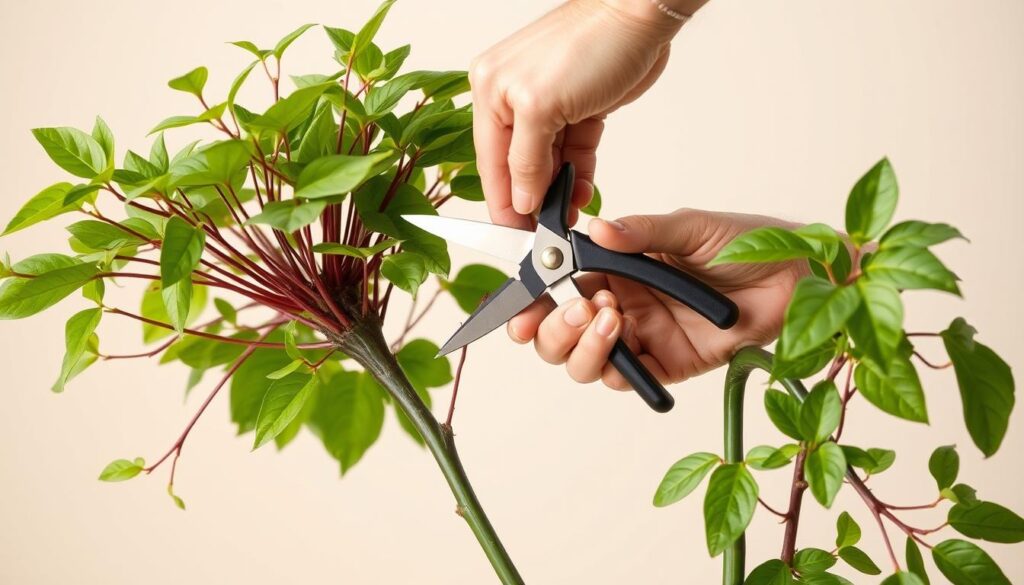
Here are some care tips to keep in mind when pruning your umbrella plant:
- Remove dead, diseased, deformed, or dying branches to maintain the plant’s health.
- Prune back overgrown branches to control the plant’s height and shape.
- Use a gentle touch when pruning young or small umbrella plants, as they can recover less easily from serious pruning.
By following these care tips and pruning your umbrella plant regularly, you can help maintain its health and appearance, and enjoy the many benefits of having an umbrella plant in your home or garden.
Common Pests and Problems
As you learn how to grow and care for your umbrella plant, it’s essential to be aware of common pests and problems that can affect houseplants. Regular inspections of your plant can help you detect issues early, preventing large infestations from developing. Some common pests that can affect umbrella plants include spider mites, mealybugs, and scale insects.
These pests can cause significant damage to your plant, including yellowing and dropping of leaves. To prevent this, it’s crucial to learn about plant care and how to identify common pests. For example, spider mites can cause mottled leaves and fine webbing, while mealybugs can leave a sticky mess on your plant.
To effectively manage pest populations, you can use neem oil, insecticidal soap, or horticultural oil. It’s also important to maintain good plant care habits, such as allowing the soil to dry out between waterings and providing your plant with sufficient light and humidity. By following these tips, you can help keep your umbrella plant healthy and thriving.
Some additional tips for preventing pest infestations include:
- Regularly inspecting your plant for signs of pests
- Using sticky traps to catch pests
- Maintaining good air circulation around your plant
- Avoiding overwatering, which can attract pests like fungus gnats
By being aware of these common pests and problems and taking steps to prevent them, you can enjoy the many benefits of having an umbrella plant in your home, including its aesthetic appeal and air-purifying properties.
Propagation of Umbrella Plants
When it comes to propagation, umbrella plants are relatively easy to work with. One of the most common methods is using stem cuttings, which can be taken from the terminal ends of the plant. To increase the chances of successful propagation, it’s recommended to take cuttings during the summer months when the plant is actively growing.
For optimal results, the cuttings should be around 10 centimeters long and contain three to five leaves. The ideal temperature for growing cuttings is between 15 to 20 °C, and high humidity is crucial for successful propagation processes. The cutting soil should have low nutrient content to stimulate root growth, and the water should be changed two to three times a week to ensure the health of the cuttings.
Some key tips for plant care during the propagation process include:
- Keeping the soil consistently moist but not waterlogged
- Providing high humidity to promote root growth
- Using a well-draining potting mix to prevent root rot
By following these tips and using the right techniques, you can successfully propagate your umbrella plant and enjoy the benefits of having more of these beautiful plants in your home.
Decorating with Umbrella Plants
When it comes to decorating with umbrella plants, there are many creative ways to incorporate them into your indoor or outdoor space. As a low-maintenance houseplant, umbrella plants are perfect for those who want to add some greenery to their home without requiring a lot of care. With over 5,000 people searching for ideas related to Umbrella trees on Pinterest, it’s clear that these plants are a popular choice for home decor.
One of the best things about umbrella plants is their ability to thrive in low-light conditions, making them optimal for indoor settings. They can grow up to 10 feet tall indoors, while shorter varieties can reach around 4 feet in height. To keep your umbrella plant happy and healthy, make sure to provide it with proper lighting and watering. Overwatering can lead to root rot, so it’s essential to allow the soil to dry completely between watering.
- Choose a spot with bright, indirect light to bring out the plant’s natural beauty
- Use a well-draining potting mix to prevent waterlogged soil
- Water sparingly, allowing the soil to dry completely between watering
- Fertilize regularly to promote healthy growth and development
By following these care tips, you can keep your umbrella plant thriving and enjoy its beautiful foliage for years to come. Whether you’re looking to add some greenery to your home or office, umbrella plants are a great choice for indoor plants.
Frequently Asked Questions about Umbrella Plants
As you’ve learned, the umbrella plant (Schefflera arboricola) is a versatile and low-maintenance houseplant that can thrive in various indoor environments. But you may still have some lingering questions about its care and maintenance. Let’s address some of the most common concerns and get expert tips to ensure your umbrella plant stays healthy and vibrant.
Common Concerns
One of the most common issues with umbrella plants is leaf drop. This can occur due to factors like underwatering, overwatering, or insufficient light. If you notice your umbrella plant’s leaves starting to droop or turn yellow, adjust your watering schedule and ensure it’s getting enough indirect sunlight.
Another concern is pests, such as mealybugs or spider mites. Regular use of a plant sprayer can help prevent these issues by maintaining proper humidity levels around your umbrella plant. Closely inspect the leaves and stems for any signs of infestation and treat promptly if necessary.
Expert Tips
When it comes to caring for your umbrella plant, our experts recommend repotting every 2-3 years to encourage healthy root growth and nutrient uptake. Additionally, fertilizing monthly during the growing season can help your Schefflera arboricola thrive.
For optimal growth, place your umbrella plant in a spot that receives medium to bright, indirect sunlight, maintaining temperatures between 18-24°C (65-75°F). Proper watering is also crucial – allow the top 50-70% of the soil to dry out before watering again, and be mindful of signs of over or underwatering.
With these expert tips and by addressing any common concerns, you’ll be well on your way to enjoying a vibrant and long-lasting umbrella plant in your home or office. Happy planting!
FAQ
What are the ideal light requirements for an umbrella plant?
Umbrella plants prefer bright, indirect light. They can tolerate some direct sunlight, but too much direct sun can scorch the leaves. Aim to place your umbrella plant in a spot that receives 4-6 hours of bright, indirect light per day.
How often should I water my umbrella plant?
The watering frequency for an umbrella plant depends on various factors, such as the size of the plant, the potting soil, and the environmental conditions. As a general rule, allow the top inch or two of soil to dry out between waterings. Avoid letting the soil become completely dry or become waterlogged.
How can I tell if my umbrella plant is getting too much or too little water?
Signs of overwatering include yellow, wilting, or mushy leaves, while signs of underwatering include dry, curling, or crispy leaves. If the leaves are dropping, it could be a sign of either over or underwatering, so it’s important to check the soil moisture level to determine the issue.
What type of fertilizer should I use for my umbrella plant?
Umbrella plants benefit from a balanced, water-soluble fertilizer. Look for a fertilizer with an N-P-K ratio of 10-10-10 or 20-20-20. Apply the fertilizer every 2-3 months during the growing season, following the manufacturer’s instructions for the appropriate dosage.
How do I propagate an umbrella plant?
Umbrella plants can be propagated through stem cuttings or division. To propagate from stem cuttings, take a cutting from a healthy stem, remove the lower leaves, and place it in moist, well-draining potting soil or a water-filled container. To propagate through division, gently remove the plant from its pot and separate the root ball into smaller sections, ensuring each section has roots and leaves.
What are some common pests and problems that can affect umbrella plants?
Common pests that can affect umbrella plants include spider mites, mealybugs, and scale insects. These pests can cause yellowing, wilting, or discoloration of the leaves. Umbrella plants can also be susceptible to root rot if they are overwatered or planted in poorly draining soil.
Source Links
- Umbrella Plant (Schefflera) Care and Growing Tips – https://www.birdsandblooms.com/gardening/small-space-gardening/umbrella-plant-schefflera-care/?srsltid=AfmBOoqWZM9pxYAxhU0dkPujscpUHkOgL1Csx9cM3G1FDH_SAg39NrQn
- Umbrella Plant Care Instructions – https://plantify.co.za/pages/umbrella-plant-care-instructions?srsltid=AfmBOor6Y3KoLtENlv_RSn9kb7z9RUdm35XkXrDAZPt9X8k_nGvSRM6o
- Cafe Planta – https://cafeplanta.com/a/blog/the-ultimate-guide-to-umbrella-plant-leaves-everything-you-need-to-know
- Umbrella plant: Schefflera types & cultivation – Plantura – https://plantura.garden/uk/houseplants/umbrella-plant/umbrella-plant-overview
- Umbrella Plant | Perennials – https://www.greatgardenplants.com/products/umbrella-plant?srsltid=AfmBOooxOsS1wKYQZiQmhTdIDck188rf4hj40l2LT2w8CS3RUA7ukVr9
- How to Care for an Umbrella Plant (Schefflera) – https://cheekyplantco.com.au/blogs/plants-blog/how-to-care-for-an-umbrella-plant-schefflera?srsltid=AfmBOorTB2nBJMKU5K6shKqeTWrbwxAssTxnGgVRPPiv_RRn1LZSyLjw
- Symbolism And Benefits Of The Umbrella Tree – https://greg.app/umbrella-tree-benefits/
- Cafe Planta – https://cafeplanta.com/a/blog/the-surprising-benefits-of-the-umbrella-plant
- Cafe Planta – https://cafeplanta.com/a/blog/understanding-the-role-and-care-of-umbrella-plant-aerial-roots
- Umbrella Plant (Schefflera) Care and Growing Tips – https://www.birdsandblooms.com/gardening/small-space-gardening/umbrella-plant-schefflera-care/?srsltid=AfmBOoqcXZEIYTHUvluOiA_PQoM2NP2kJZ–DqjrcsNaL5s1ymJR6XGt
- Schefflera care (Umbrella plant) – Expert Advice | PLNTS.com – https://plnts.com/en/care/houseplants-family/schefflera
- How to grow and care for umbrella plant (Schefflera) – https://www.gardenersworld.com/house-plants/umbrella-plant-care/
- How to Grow & Care for Schefflera (Umbrella Plant) – https://www.thespruce.com/grow-schefflera-plants-inside-1902771
- umbrella plant Care 101: Water, Light & Growing Tips – https://greg.app/plant-care/schefflera-gerda-umbrella-plant
- Umbrella plant care: pruning, watering & more – Plantura – https://plantura.garden/uk/houseplants/umbrella-plant/umbrella-plant-care
- Umbrella Plant Care Guide – https://36vine.com/blogs/plant-care-guides/umbrella-plant/
- Umbrella Tree – Ultimate Guide to Fertilizing – https://greg.app/umbrella-tree-fertilizer/
- Master Umbrella Plant Care for a Cheerful Indoor Tree, Rain or Shine – https://www.bobvila.com/articles/umbrella-plant-care/
- Umbrella Tree Guide: How to Grow and Care for Schefflera – https://www.planetnatural.com/umbrella-tree/
- When and How to Prune Umbrella Plants (Schefflera) – https://gardenerspath.com/plants/houseplants/prune-schefflera/
- Schefflera Plant Pruning: Tips On Cutting Back Schefflera Plants – https://www.gardeningknowhow.com/houseplants/schefflera/schefflera-plant-pruning.htm
- What Are The Bugs on My Umbrella Tree? 🐛 – https://greg.app/bugs-on-umbrella-tree/
- Umbrella plant with sticky substance on its leaves – https://aces.nmsu.edu/ces/yard/2005/011505.html
- 🐛 What To Do About Bugs on My Dwarf Umbrella Tree? – https://greg.app/bugs-on-dwarf-umbrella-tree/
- Umbrella plant propagation: different techniques – Plantura – https://plantura.garden/uk/houseplants/umbrella-plant/umbrella-plant-propagation
- Learn How to Propagate an Umbrella Plant With These 3 Proven Techniques – https://www.livelyroot.com/blogs/plant-care/umbrella-tree-plant-propagation?srsltid=AfmBOorhEwjJ0US1nInGWJ_UmDuxzJOmJ7bCMdDgkhg9Vksy0AqVy3iw
- Umbrella Tree – https://www.pinterest.com/ideas/umbrella-tree/940190091879/
- Meet a Houseplant That Doesn’t Mind Neglect – https://www.houzz.com/magazine/meet-a-houseplant-that-doesn-t-mind-neglect-stsetivw-vs~12932617
- How to care for an umbrella plant – 5 expert tips for this tree that doesn’t mind neglect – https://www.homesandgardens.com/gardens/how-to-care-for-an-umbrella-plant
- How to care for an Umbrella plant (Schefflera)? – https://www.studioplant.com/en/care-guide/umbrella-plant
- Umbrella Plant (Schefflera) Care and Growing Tips – https://www.birdsandblooms.com/gardening/small-space-gardening/umbrella-plant-schefflera-care/?srsltid=AfmBOoowVwHGlIid2hR_MjOcPaPsj249nLwMEHbaOtd9MwFcBiLMhuXs
- Umbrella Plant Propagation: A Complete How-To Guide – https://www.gardeningknowhow.com/houseplants/schefflera/schefflera-plant-cuttings.htm

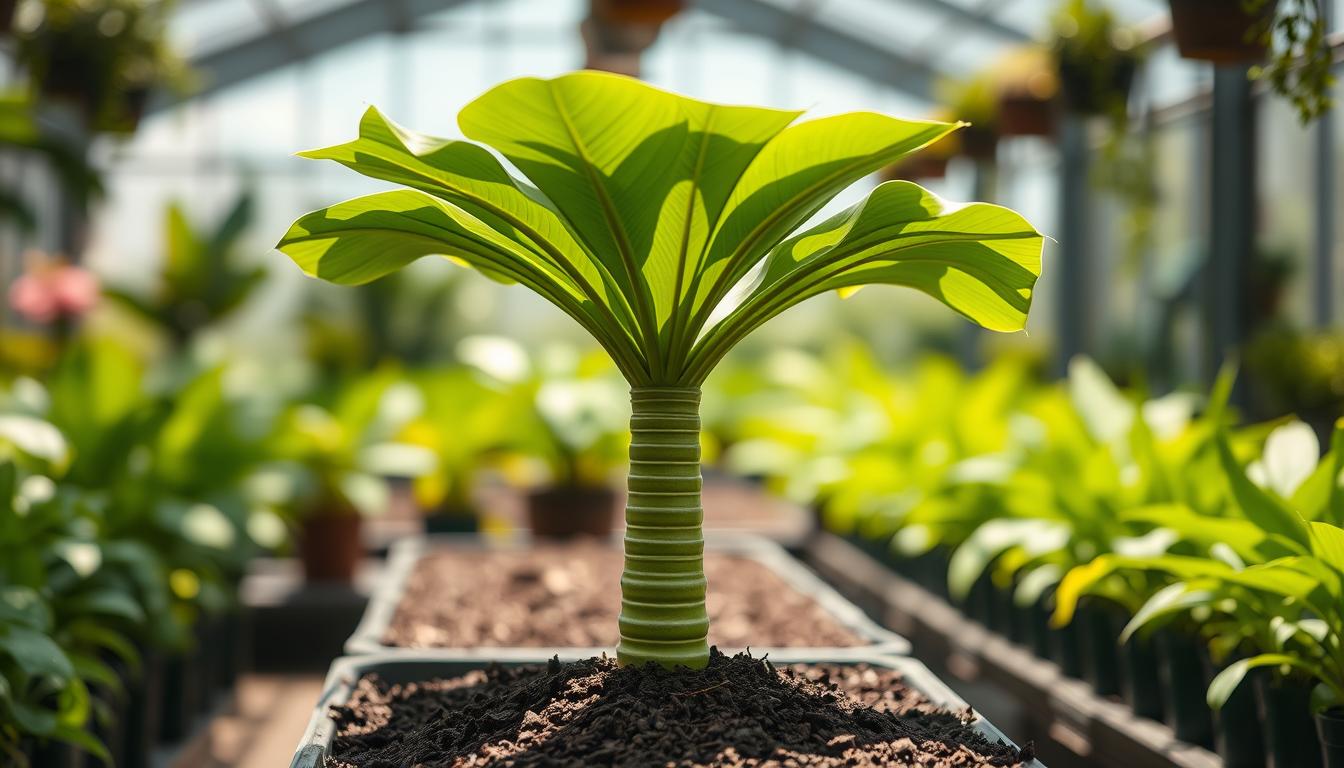
1 thought on “The Ultimate Guide to Umbrella Plants: Planting, Caring & Enjoying”